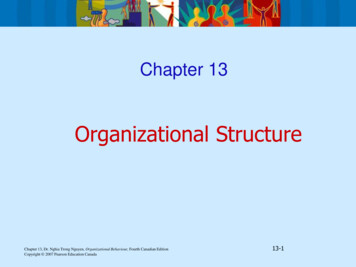
Transcription
Chapter 13Organizational StructureChapter 13, Dr. Nghia Trong Nguyen, Organizational Behaviour, Fourth Canadian EditionCopyright 2007 Pearson Education Canada13-1
Chapter Outline What Is Organizational Structure?Mechanistic and Organic OrganizationsTraditional Organizational DesignsNew Design OptionsWhat Major Forces Shape an Organization’sStructure?Chapter 13, Dr. Nghia Trong Nguyen, Organizational Behaviour, Fourth Canadian EditionCopyright 2007 Pearson Education Canada13-2
Organizational Structure1. What are the key elements of organizationalstructure?2. How flexible can organizational structures be?3. What are some examples of traditionalorganizational designs?4. What do newer organizational structures look like?5. Why do organizational structures differ?Chapter 13, Dr. Nghia Trong Nguyen, Organizational Behaviour, Fourth Canadian EditionCopyright 2007 Pearson Education Canada13-3
Exhibit 13-1 PyramidalOrganizational StructureChapter 13, Dr. Nghia Trong Nguyen, Organizational Behaviour, Fourth Canadian EditionCopyright 2007 Pearson Education Canada13-4
Exhibit 13-2Flat Organizational StructureChapter 13, Dr. Nghia Trong Nguyen, Organizational Behaviour, Fourth Canadian EditionCopyright 2007 Pearson Education Canada13-5
Exhibit 13-4 Departmentalizationby CityOrgChart2005.pdf. Reprintedby permission of the City ogKingston.Chapter 13, Dr. Nghia Trong Nguyen, Organizational Behaviour, Fourth Canadian EditionCopyright 2007 Pearson Education Canada13-6
Exhibit 13-5Departmentalization by ProductNortel NetworksWirelessNetworksEnterpriseNetworksChapter 13, Dr. Nghia Trong Nguyen, Organizational Behaviour, Fourth Canadian EditionCopyright 2007 Pearson Education CanadaWirelineNetworksOpticalNetworks13-7
Exhibit 13-6 Departmentalizationby GeographyRoyal Bank of CanadaCanadaAsiaChapter 13, Dr. Nghia Trong Nguyen, Organizational Behaviour, Fourth Canadian EditionCopyright 2007 Pearson Education CanadaEuropeUnited States13-8
Exhibit 13-7Departmentalization by CustomerDell CanadaIndividualSystemsBusinessSystemsSmall BusinessUsersChapter 13, Dr. Nghia Trong Nguyen, Organizational Behaviour, Fourth Canadian EditionCopyright 2007 Pearson Education CanadaMedium/LargeBusiness UsersGovernment,Education,Health Care13-9
Exhibit 13-8 ContrastingSpans of ControlMembers at each level(Highest)Organizational LevelAssuming span of 4Assuming span of 811124831664464512525640966102474096Operatives 4096Managers (Levels 1 – 6) 1365Chapter 13, Dr. Nghia Trong Nguyen, Organizational Behaviour, Fourth Canadian EditionCopyright 2007 Pearson Education CanadaOperatives 4096Managers (Levels 1 – 4) 58513-10
Exhibit 13-10 Mechanisticvs. Organic ModelsThe organic modelThe mechanistic model High specializationRigid departmentalizationClear chain of commandNarrow spans of controlCentralizationHigh formalizationChapter 13, Dr. Nghia Trong Nguyen, Organizational Behaviour, Fourth Canadian EditionCopyright 2007 Pearson Education Canada Cross-functional teamsCross-hierarchical teamsFree flow of informationWide spans of controlDecentralizationLow formalization13-11
Exhibit 13-11Matrix StructureAcademic tudiesFinanceInformation anddecision vemethodsChapter 13, Dr. Nghia Trong Nguyen, Organizational Behaviour, Fourth Canadian EditionCopyright 2007 Pearson Education Canada13-12CommunityService
Exhibit 13-13Modular StructureOrganizational InfrastructureHuman OperationsMarketingand SalesServiceOUTSOURCEDChapter 13, Dr. Nghia Trong Nguyen, Organizational Behaviour, Fourth Canadian EditionCopyright 2007 Pearson Education Canada13-13
Exhibit 13-14Virtual StructureOrganizational InfrastructureHuman ResourceManagementAlliancePartner ngand SalesServiceAlliancePartner BAlliancePartner CAlliancePartner DAlliancePartner EChapter 13, Dr. Nghia Trong Nguyen, Organizational Behaviour, Fourth Canadian EditionCopyright 2007 Pearson Education Canada13-14
Exhibit 13-16Model of the cChapter 13, Dr. Nghia Trong Nguyen, Organizational Behaviour, Fourth Canadian EditionCopyright 2007 Pearson Education Canada13-15
Summary and Implications1. What are the key elements of organizationalstructure?–There are six key elements that managers need toaddress when they design their organization’s structure:work specialization, departmentalization, chain ofcommand, span of control, centralization anddecentralization, and formalization.2. How flexible can organizational structures be?–There are two models that determine how flexible anorganizations can be: mechanistic and organic.Chapter 13, Dr. Nghia Trong Nguyen, Organizational Behaviour, Fourth Canadian EditionCopyright 2007 Pearson Education Canada13-16
Summary and Implications3.What are some examples of traditional organizational designs?– Some of the more common organizational designs found inuse are the simple structure, the bureaucracy, and the matrixstructure.4. What do newer organizational structures look like?– The new structural options for organizations involve breakingdown the boundaries in some fashion, either internally,externally, or a combination of the two.5. Why do organizational structures differ?– Strategy, organizational size, technology, and environmentdetermine the type of structure.Chapter 13, Dr. Nghia Trong Nguyen, Organizational Behaviour, Fourth Canadian EditionCopyright 2007 Pearson Education Canada13-17
For Review1. Why isn’t work specialization an unending source ofincreased productivity?2. What are the different forms of departmentalize?3. All things being equal, which is more efficient, a wideor narrow span of control? Why?4. What is a matrix structure? When would managementuse it?5. How does a family business differ from otherorganizational structures?Chapter 13, Dr. Nghia Trong Nguyen, Organizational Behaviour, Fourth Canadian EditionCopyright 2007 Pearson Education Canada13-18
For Review6. Contrast the virtual organization with theboundaryless organization.7. What type of structure works best with an innovationstrategy? A cost-minimization strategy? An imitationstrategy?8. Summarize the size-structure relationship.9. Define and give an example of what is meant by theterm technology.10. Summarize the environment-structure relationship.Chapter 13, Dr. Nghia Trong Nguyen, Organizational Behaviour, Fourth Canadian EditionCopyright 2007 Pearson Education Canada13-19
structure. 4. What do newer organizational structures look like? – The new structural options for organizations involve breaking down the boundaries in some fashion, either internally, externally, or a combination of the two. 5. Why do organizational structures differ? – Strategy, organizational size, technology, and environment